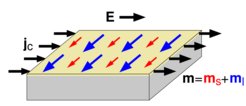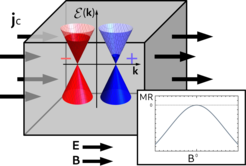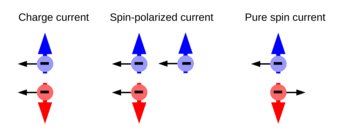Spin-Orbital Electronics
Minerva Fast Track Group
The Minerva Fast Track Group "Spin-Orbital Electronics" is led by Dr. Annika Johansson and was started in October 2021. The main focus of our research is the theoretical consideration of spin-orbit driven transport phenomena relating electronic and magnetic properties.

While conventional semiconductor technology is based on charge currents, the idea of spintronics is to additionally use the spin degree of freedom, which is one origin of magnetism, for storage, processing, and transfer of data. Spintronic devices are expected to be more energy-efficient and faster than conventional semiconductor devices, and to be nonvolatile. We are working on identifying mechanisms to efficiently generate spin currents and spin polarization directly in nonmagnetic materials. The crucial interaction for these effects is spin-orbit coupling, which names this subfield of spintronics spin-orbitronics.
Besides the spin, also the orbital angular momentum of the charge carriers can contribute to magnetism. Therefore, we consider effects relating both spin and orbital moment to electronic properties, such as the Edelstein effect and the chiral anomaly. Besides conventional metals and semiconductors we examine topologically nontrivial materials like topological insulators and Weyl semimetals, which can exhibit unique spin-orbitronic effects.
Spin-charge interconversion: The Edelstein effect

In systems with broken inversion symmetry, such as metal surfaces or crystals without an inversion center, the application of an electric field can generate a charge current and, in addition, a homogeneous spin density, even if the system is nonmagnetic in equilibrium. This current-induced spin density, which comes along with a nonequilibrium magnetization, is known as Edelstein effect. Our aim is to identify materials providing an efficient spin-charge interconversion via the Edelstein effect, and to predict and control the magnitude as well as the direction of the current-induced spin polarization. Besides the conventional Edelstein materials, which are Rashba systems at metal surfaces or semiconductor interfaces, we investigate the Edelstein effect in topologically nontrivial materials, and were able to predict Weyl semimetals to exhibit a very large Edelstein effect.
Orbital transport
Spin-dependent transport phenomena have been discussed intensely in the last three decades. Recently, their orbital analogs, e.g. phenomena that generate currents of orbital moment, and the interaction of spin and orbital transport properties, have attracted increasing attention. Considering the spin and the orbital Edelstein effects, we found that in two-dimensional oxide interfaces the orbital Edelstein contribution can exceed its spin counterpart by one order of magnitude and therefore dominate the magnitude as well as the direction of the current-induced magnetization. We are further interested in the role of the orbital magnetic moment for the electron dynamics, and its influence on charge, heat, spin, and orbital transport.
Chiral anomaly and related transport phenomena

Weyl semimetals are interpreted as the solid-state realization of Weyl fermions. Their band structures feature so-called Weyl points, where two nondegenerate bands touch in a cone-like dispersion. Each Weyl point has a nonzero chirality and is an (anti-)monopole of Berry curvature. Due to their topologically nontrivial character, Weyl semimetals feature topological surface states. In Weyl semimetals, the application of nonorthogonal electric and magnetic fields leads to a non-conservation of chiral charge, known as chiral anomaly. The chiral anomaly is accompanied by unique transport properties such as a negative longitudinal magnetoresistance and a large planar Hall effect. We analyze the electric, thermal, and thermoelectric transport properties under the influence of external magnetic fields with a focus on the interplay of Lorentz force and chiral anomaly.


